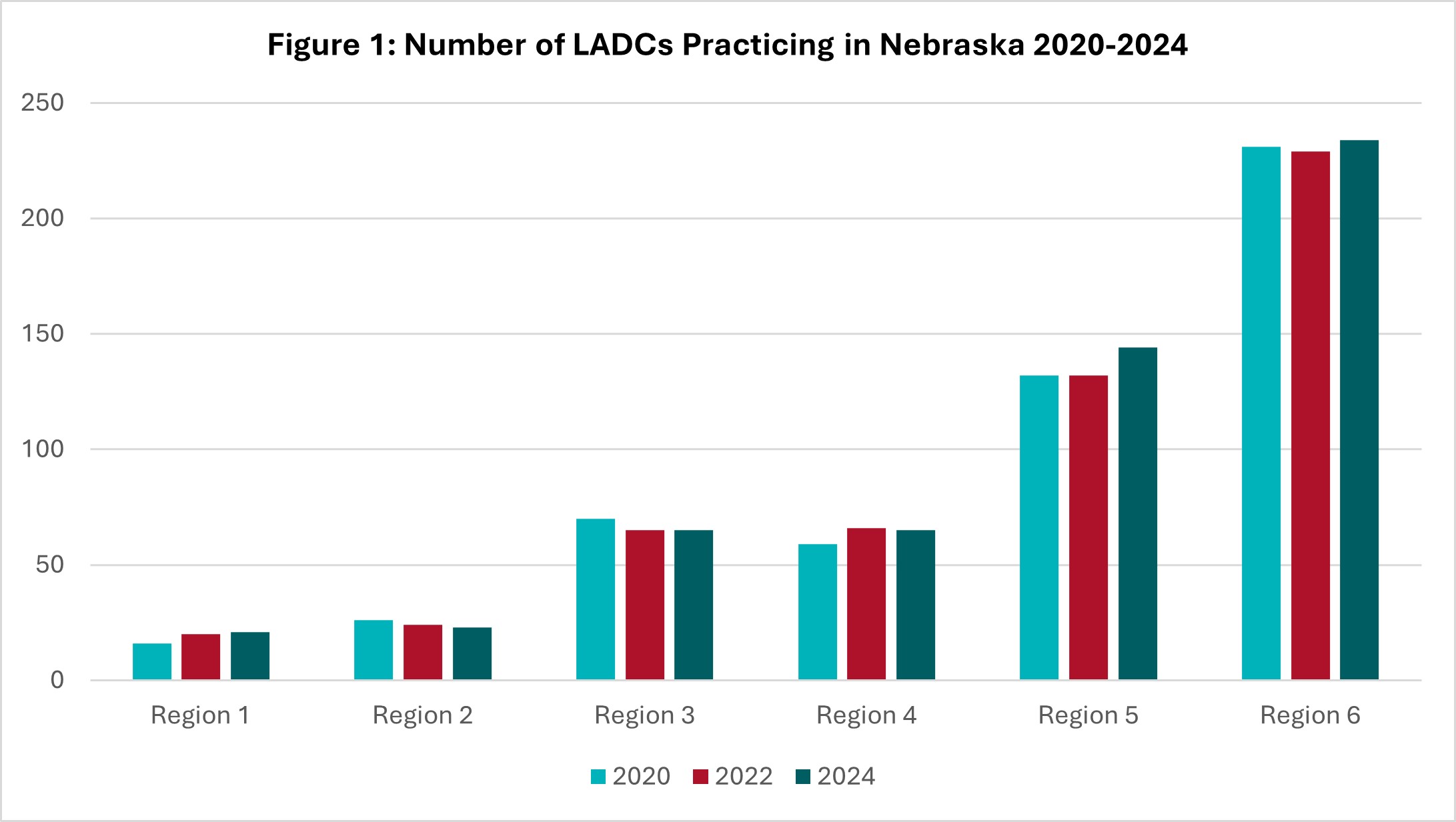The Licensed Alcohol and Drug Counselor Workforce in Nebraska: 2020 to 2024
Purpose
BHECN utilizes data from the UNMC Health Professions Tracking Service to determine the number and type of licensed behavioral health professionals who practice in Nebraska. This data snapshot includes information about the Licensed Alcohol and Drug Counselor (LADC) workforce from 2020 to 2024.
LADCs evaluate individuals for substance use disorder, assess openness to treatment, develop treatment goals, recommend treatment options and help clients develop skills to recover from substance use disorder. They also assist and teach families about substance use disorders and refer clients to community resources.
Key Findings
- The Nebraska LADC workforce grew 4% from 2020 to 2024.
- The number of LADCs increased in four of the six Nebraska Behavioral Health Regions and in rural areas.
- The number of LADCs per 100,000 residents exceeds the national average in both urban and rural areas.
Regional Trends
The number of licensed LADCs practicing in Nebraska increased 4% from 2020 to 2024 (from 534 to 553). The number of LADCs increased in Nebraska Behavioral Health Regions 1, 4, 5, and 6, and decreased in Regions 2 and 3 (see Figure 1).[1], [2]
Rural and Urban Distribution of LADCs
The number of LADCs per 100,000 residents in rural areas increased in 2024, but decreased in urban areas. However, rural areas still have fewer LADCs per 100,000 population compared to urban areas (see Figure 2). At 25+ LADCs per 100,000 population, Nebraska counties (both urban and rural) exceed the national average of 20 LADCs per 100,000 population.[3]

Age of LADCs
Since 2020, the number of LADCs at or near retirement age is nearly flat, and the number of LADCs ages 46-55 has increased (see Figure 3).

LADC Training Programs
LADC training for licensure in Nebraska requires 270 hours of education (about 2 years) and 6,000 hours[4] of supervised paid clinical work experience in alcohol and drug counseling, which is usually obtained during the provisional licensing period.
Nine education programs in the state have DHHS pre-approved coursework which meets the 270-hour requirement: Chadron State College and Western Nebraska Community College (Region 1), Central Community College and UNK (Region 3), Northeast Community College (Region 4), Peru State College, Southeast Community College, and Union Adventist University (Region 5), and Bellevue University (Region 6). Additionally, Metro Community College (Region 6) offers an Associate’s degree in Applied Science, Alcohol and Drug Counseling that meets NE DHHS requirements.
Conclusions
The LADC workforce in Nebraska has grown since 2020, with four of the six Nebraska Behavioral Health Regions experiencing an increase in numbers, including those in rural areas. The availability of LADCs remains higher in urban areas compared to rural areas, though the number of providers per 100,000 residents exceeds the national average. Nearly every Behavioral Health Region in the state offers educational opportunities to become a licensed LADC. Overall, these findings highlight positive changes in the Nebraska LADC workforce along with the need for continued efforts to ensure the number of LADCs remains sufficient to meet the needs of Nebraska residents.
Suggested citation:
Behavioral Health Education Center of Nebraska. (2025). The Licensed Alcohol and Drug Counselor Workforce in Nebraska: 2020 to 2024. https://www.unmc.edu/bhecn/research-data-policy/2020_2024_ladc_snapshot.html
Footnotes
[1] Nebraska Department of Health and Human Services. (2025). Behavioral Health Resources for Schools: Division of Behavioral Health. https://dhhs.ne.gov/BHSchoolResources/AboutDBH.pdf
[2] This document presents non-hierarchical counts of LADCs, which means all LADCs are included in these numbers, regardless of whether they hold other license types. Since LADCs often also hold LMHP/LIMHP licenses, they are undercounted when hierarchical counts are presented.
[3] Zippia. (2025). Substance Abuse Counselor Demographics and Statistics in the US. https://www.zippia.com/substance-abuse-counselor-jobs/demographics/
[4] For LADCs who only have a high school diploma or GED. For those with higher education degrees, the supervised practice hours requirements are as follows: Associate’s = 5,000; Bachelor’s = 4,000; Master’s = 2,000. LADCs often have dual licensure as LMHPs or LIMHPs.
